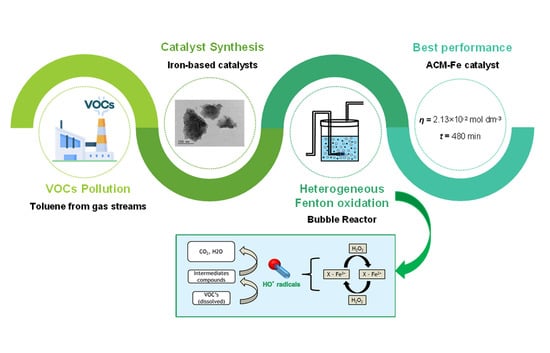Degradation of Toluene from Gas Streams by Heterogeneous Fenton Oxidation in a Slurry Bubble Reactor with Activated Carbon-Based Catalysts
Abstract
:1. Introduction
2. Materials and Methods
2.1. Materials
2.2. Activated Carbons Functionalization
2.3. Catalysts Preparation
2.4. Carbon Materials Characterization
2.5. Experimental Procedure
2.5.1. Simulated Toluene Gas Stream
2.5.2. Adsorption and Reaction Experiments
2.6. Analytical Methods
3. Results and Discussion
3.1. Carbon Materials Characterization
3.2. Heterogeneous Fenton Reaction
3.2.1. Processes Screening
3.2.2. Effects of the Materials’ Chemical and Textural Properties
3.2.3. Stability of the ACM-Activated Carbon and ACM-Fe Catalyst
4. Conclusions
Supplementary Materials
Author Contributions
Funding
Conflicts of Interest
References
- Xie, R.; Ji, J.; Huang, H.; Lei, D.; Fang, R.; Shu, Y.; Zhan, Y.; Guo, K.; Leung, D.Y.C. Heterogeneous Activation of Peroxymonosulfate over Monodispersed Co3O4/Activated Carbon for Efficient Degradation of Gaseous Toluene. Chem. Eng. J. 2018, 341, 383–391. [Google Scholar] [CrossRef]
- Loh, M.M.; Houseman, E.A.; Gray, G.M.; Levy, J.I.; Spengler, J.D.; Bennett, D.H. Measured Concentrations of VOCs in Several Non-Residential Microenvironments in the United States. Environ. Sci. Technol. 2006, 40, 6903–6911. [Google Scholar] [CrossRef] [PubMed]
- Ji, J.; Xu, Y.; Huang, H.; He, M.; Liu, S.; Liu, G.; Xie, R.; Feng, Q.; Shu, Y.; Zhan, Y.; et al. Mesoporous TiO2 under VUV Irradiation: Enhanced Photocatalytic Oxidation for VOCs Degradation at Room Temperature. Chem. Eng. J. 2017, 327, 490–499. [Google Scholar] [CrossRef]
- Bouzaza, A.; Vallet, C.; Laplanche, A. Photocatalytic Degradation of Some VOCs in the Gas Phase Using an Annular Flow Reactor: Determination of the Contribution of Mass Transfer and Chemical Reaction Steps in the Photodegradation Process. J. Photochem. Photobiol. A Chem. 2006, 177, 212–217. [Google Scholar] [CrossRef]
- Chen, H.L.; Lee, H.M.; Chen, S.H.; Chang, M.B.; Yu, S.J.; Li, S.N. Removal of Volatile Organic Compounds by Single-Stage and Two-Stage Plasma Catalysis Systems: A Review of the Performance Enhancement Mechanisms, Current Status, and Suitable Applications. Environ. Sci. Technol. 2009, 43, 2216–2227. [Google Scholar] [CrossRef]
- Colmenares, J.C.; Magdziarz, A.; Łomot, D.; Chernyayeva, O.; Lisovytskiy, D. A New Photocatalytic Tool in VOCs Abatement: Effective Synergetic Combination of Sonication and Light for the Synthesis of Monometallic Palladium-Containing TiO2. Appl. Catal. B 2014, 147, 624–632. [Google Scholar] [CrossRef]
- Magureanu, M.; Mandache, N.B.; Eloy, P.; Gaigneaux, E.M.; Parvulescu, V.I. Plasma-Assisted Catalysis for Volatile Organic Compounds Abatement. Appl. Catal. B 2005, 61, 12–20. [Google Scholar] [CrossRef]
- USEPA. Toxicological Review of Toluene. 2005; Volume 179. Available online: https://iris.epa.gov/static/pdfs/0118tr.pdf (accessed on 21 July 2022).
- USEPA. Priority Pollutant List. Effl. Guidel. 2014; pp. 1–2. Available online: https://www.epa.gov/sites/default/files/2015-09/documents/priority-pollutant-list-epa.pdf (accessed on 21 July 2022).
- Ge, J.C.; Kim, J.H.; Choi, N.J. Electrospun Polyurethane/Loess Powder Hybrids and Their Absorption of Volatile Organic Compounds. Adv. Mater. Sci. Eng. 2016, 8521259. [Google Scholar] [CrossRef]
- Štandeker, S.; Novak, Z.; Knez, Ž. Removal of BTEX Vapours from Waste Gas Streams Using Silica Aerogels of Different Hydrophobicity. J. Hazard Mater 2009, 165, 1114–1118. [Google Scholar] [CrossRef]
- Daifullah, A.A.M.; Girgis, B.S. Impact of Surface Characteristics of Activated Carbon on Adsorption of BTEX. Colloids Surf. A Physicochem. Eng. Asp. 2003, 214, 181–193. [Google Scholar] [CrossRef]
- Ambrozek, B.; Zwarycz-Makles, K. Theoretical and Experimental Studies of the Recovery of Volatile Organic Compounds from Waste Air Streams in the Thermal Swing Adsorption System with Closed-Loop Regeneration of Adsorbent. Energy Convers. Manag. 2014, 85, 646–654. [Google Scholar] [CrossRef]
- Corsi, R.L.; Seed, L. Biofiltration of BTEX: Media, Substrate, and Loadings Effects. Environ. Prog. 1995, 14, 151–158. [Google Scholar] [CrossRef]
- Bekbolet, M. Fundamentals of Advanced Oxidation Processes. In Water, Wastewater and Soil Treatment by Advanced Oxidation Processes (AOPs); Belgiorno, V., Naddeo, V., Rizzo, L., Eds.; Sanitary Environmental Engineering Division (SEED): Fisciano, SA, Italy, 2011; pp. 13–21. [Google Scholar]
- Deng, Y.; Zhao, R. Advanced Oxidation Processes (AOPs) in Wastewater Treatment. Curr. Pollut. Rep. 2015, 1, 167–176. [Google Scholar] [CrossRef]
- Papadopoulos, A.E.; Fatta, D.; Loizidou, M. Development and Optimization of Dark Fenton Oxidation for the Treatment of Textile Wastewaters with High Organic Load. J. Hazard Mater 2007, 146, 558–563. [Google Scholar] [CrossRef] [PubMed]
- Rosenfeldt, E.J.; Linden, K.G. The ROH, UV Concept to Characterize and the Model UV/H2O2 Process in Natural Waters. Environ. Sci. Technol. 2007, 41, 2548–2553. [Google Scholar] [CrossRef]
- Walling, C. Fenton’s Reagent Revisited. Acc. Chem. Res. 1975, 8, 125–131. [Google Scholar] [CrossRef]
- Cheng, M.; Zeng, G.; Huang, D.; Lai, C.; Xu, P.; Zhang, C.; Liu, Y.; Wan, J.; Gong, X.; Zhu, Y. Degradation of Atrazine by a Novel Fenton-like Process and Assessment the Influence on the Treated Soil. J. Hazard Mater 2016, 312, 184–191. [Google Scholar] [CrossRef]
- Bigda, R.J. Consider Fenton’s Chemistry for Wastewater Treatment. Chem. Eng. Prog. 1995, 91, 62–66. [Google Scholar]
- Bautista, P.; Mohedano, A.F.; Casas, J.A.; Zazo, J.A.; Rodriguez, J.J. An Overview of the Application of Fenton Oxidation to Industrial Wastewaters Treatment. J. Chem. Technol. Biotechnol. 2008, 83, 1323–1338. [Google Scholar] [CrossRef]
- Mesquita, A.M.; Guimarães, I.R.; de Castro, G.M.M.; Gonçalves, M.A.; Ramalho, T.C.; Guerreiro, M.C. Boron as a Promoter in the Goethite (α-FeOOH) Phase: Organic Compound Degradation by Fenton Reaction. Appl. Catal. B 2016, 192, 286–295. [Google Scholar] [CrossRef]
- Rodrigues, C.S.D.; Soares, O.S.G.P.; Pinho, M.T.; Pereira, M.F.R.; Madeira, L.M. P-Nitrophenol Degradation by Heterogeneous Fenton’s Oxidation over Activated Carbon-Based Catalysts. Appl. Catal. B 2017, 219, 109–122. [Google Scholar] [CrossRef]
- Lima, V.N.; Rodrigues, C.S.D.; Madeira, L.M. Sequential Gas-Liquid Treatment for Gaseous Toluene Degradation by Fenton’s Oxidation in Bubble Reactors. J. Environ. Chem. Eng. 2020, 8, 103796, ISBN 3512250815. [Google Scholar] [CrossRef]
- Lima, V.N.; Rodrigues, C.S.D.; Madeira, L.M. Simultaneous Treatment of Toluene-Containing Gas Waste and Industrial Wastewater by the Fenton Process. Sci. Total Environ. 2020, 749, 141497. [Google Scholar] [CrossRef]
- Poza-Nogueiras, V.; Rosales, E.; Pazos, M.; Sanromán, M.Á. Current Advances and Trends in Electro-Fenton Process Using Heterogeneous Catalysts—A Review. Chemosphere 2018, 201, 399–416. [Google Scholar] [CrossRef]
- Handa, M.; Lee, Y.; Shibusawa, M.; Tokumura, M.; Kawase, Y. Removal of VOCs in Waste Gas by the Photo-Fenton Reaction: Effects of Dosage of Fenton Reagents on Degradation of Toluene Gas in a Bubble Column. J. Chem. Technol. Biotechnol. 2013, 88, 88–97. [Google Scholar] [CrossRef]
- Sanemasa, I.; Araki, M.; Deguchi, T.; Nagai, H. Solubility Measurements of Benzene and the Alkylbenzenes in Water by Making Use of Solute Vapor. Bull Chem. Soc. Jpn 1982, 55, 1054–1062. [Google Scholar] [CrossRef]
- Xie, R.; Liu, G.; Liu, D.; Liang, S.; Lei, D.; Dong, H.; Huang, H.; Leung, D.Y.C. Wet Scrubber Coupled with Heterogeneous UV/Fenton for Enhanced VOCs Oxidation over Fe/ZSM-5 Catalyst. Chemosphere 2019, 227, 401–408. [Google Scholar] [CrossRef]
- Messele, S.A.; Soares, O.S.G.P.; Órfão, J.J.M.; Bengoa, C.; Stüber, F.; Fortuny, A.; Fabregat, A.; Font, J. Effect of Activated Carbon Surface Chemistry on the Activity of ZVI/AC Catalysts for Fenton-like Oxidation of Phenol. Catal. Today 2015, 240, 73–79. [Google Scholar] [CrossRef]
- Domínguez, C.M.; Quintanilla, A.; Ocón, P.; Casas, J.A.; Rodriguez, J.J. The Use of Cyclic Voltammetry to Assess the Activity of Carbon Materials for Hydrogen Peroxide Decomposition. Carbon N. Y. 2013, 60, 76–83. [Google Scholar] [CrossRef]
- Menéndez, J.A.; Xia, B.; Phillips, J.; Radovic, L.R. On the Modification and Characterization of Chemical Surface Properties of Activated Carbon: Microcalorimetric, Electrochemical, and Thermal Desorption Probes. Langmuir 1997, 13, 3414–3421. [Google Scholar] [CrossRef]
- Ramirez, J.H.; Maldonado-Hódar, F.J.; Pérez-Cadenas, A.F.; Moreno-Castilla, C.; Costa, C.A.; Madeira, L.M. Azo-Dye Orange II Degradation by Heterogeneous Fenton-like Reaction Using Carbon-Fe Catalysts. Appl. Catal. B 2007, 75, 312–323. [Google Scholar] [CrossRef]
- Liu, X.; Yin, H.; Lin, A.; Guo, Z. Effective Removal of Phenol by Using Activated Carbon Supported Iron Prepared under Microwave Irradiation as a Reusable Heterogeneous Fenton-like Catalyst. J. Environ. Chem. Eng. 2017, 5, 870–876. [Google Scholar] [CrossRef]
- Duarte, F.; Maldonado-Hódar, F.J.; Madeira, L.M. New Insight about Orange II Elimination by Characterization of Spent Activated Carbon/Fe Fenton-like Catalysts. Appl. Catal. B 2013, 129, 264–272. [Google Scholar] [CrossRef]
- Esteves, B.M.; Rodrigues, C.S.D.; Boaventura, R.A.R.; Maldonado-Hódar, F.J.; Madeira, L.M. Coupling of Acrylic Dyeing Wastewater Treatment by Heterogeneous Fenton Oxidation in a Continuous Stirred Tank Reactor with Biological Degradation in a Sequential Batch Reactor. J. Environ. Manag. 2016, 166, 193–203. [Google Scholar] [CrossRef]
- Figueiredo, J.L.; Pereira, M.F.R.; Freitas, M.M.A.; Órfão, J.J.M. Modification of the Surface Chemistry of Activated Carbons. Carbon N. Y. 1999, 37, 1379–1389. [Google Scholar] [CrossRef]
- Brunauer, S.; Emmett, P.H.; Teller, E. Adsorption of Gases in Multimolecular Layers. J. Am. Chem. Soc. 1938, 60, 309–319. [Google Scholar] [CrossRef]
- Figueiredo, J.L.; Ribeiro, F.R. Catálise Heterogénea, 2nd ed.; Fundação Calouste Gulbenkian: Lisboa, Portugal, 2007. [Google Scholar]
- Lippens, B.C.; Boer, J.H. de Studies on Pore Systems in Catalysts: V. The t Method. J. Catal. 1965, 4, 319–323. [Google Scholar] [CrossRef]
- Newcombe, G.; Hayes, R.; Drikas, M. Granular Activated Carbon: Importance of Surface Properties in the Adsorption of Naturally Occurring Organics. Colloids Surf. A Physicochem. Eng. Asp. 1993, 78, 65–71. [Google Scholar] [CrossRef]
- Liu, G.; Huang, H.; Xie, R.; Feng, Q.; Fang, R.; Shu, Y.; Zhan, Y.; Ye, X.; Zhong, C. Enhanced Degradation of Gaseous Benzene by a Fenton Reaction. RSC Adv. 2017, 7, 71–76. [Google Scholar] [CrossRef]
- Ramirez, J.H.; Costa, C.A.; Madeira, L.M. Experimental Design to Optimize the Degradation of the Synthetic Dye Orange II Using Fenton’s Reagent. Catal. Today 2005, 107–108, 68–76. [Google Scholar] [CrossRef]
- APHA; AWWA; WEF. Standard Methods for the Examination of Water & Wastewater; American Public Health Association: Washington, DC, USA, 2005. [Google Scholar]
- Sellers, R.M. Spectrophotometric Determination of Hydrogen Peroxide Using Potassium Titanium(IV) Oxalate. Analyst 1990, 105, 950–954. [Google Scholar] [CrossRef]
- Jaramillo, J.; Álvarez, P.M.; Gómez-Serrano, V. Oxidation of Activated Carbon by Dry and Wet Methods Surface Chemistry and Textural Modifications. Fuel Processing Technol. 2010, 91, 1768–1775. [Google Scholar] [CrossRef]
- Soares, O.S.G.P.; Órfo, J.J.M.; Gallegos-Suarez, E.; Castillejos, E.; Rodríguez-Ramos, I.; Pereira, M.F.R. Nitrate Reduction over a Pd-Cu/MWCNT Catalyst: Application to a Polluted Groundwater. Environ. Technol. 2012, 33, 2353–2358. [Google Scholar] [CrossRef]
- Rodrigues, C.S.D.; Guimarães, V.; Pereira, M.F.R.; Soares, O.S.G.P.; Madeira, L.M. Gaseous Toluene Abatement by the Heterogeneous Fenton-like Process Using Iron/Carbon-Coated Monolith as Catalyst: Proof of Concept. J. Environ. Manag. 2022, 322, 116084. [Google Scholar] [CrossRef] [PubMed]
- Moreno-Castilla, C.; Rivera-Utrilla, J.; López-Ramón, M.V.; Carrasco-Marín, F. Adsorption of Some Substituted Phenols on Activated Carbons from a Bituminous Coal. Carbon N. Y. 1995, 33, 845–851. [Google Scholar] [CrossRef]
- Dhaouadi, A.; Adhoum, N. Heterogeneous Catalytic Wet Peroxide Oxidation of Paraquat in the Presence of Modified Activated Carbon. Appl. Catal. B 2010, 97, 227–235. [Google Scholar] [CrossRef]
- Messele, S.A.; Soares, O.S.G.P.; Órfão, J.J.M.; Stüber, F.; Bengoa, C.; Fortuny, A.; Fabregat, A.; Font, J. Zero-Valent Iron Supported on Nitrogen-Containing Activated Carbon for Catalytic Wet Peroxide Oxidation of Phenol. Appl. Catal. B 2014, 154–155, 329–338. [Google Scholar] [CrossRef]
- Wang, Y.; Wei, H.; Liu, P.; Yu, Y.; Zhao, Y.; Li, X.; Jiang, W.; Wang, J.; Yang, X.; Sun, C. Effect of Structural Defects on Activated Carbon Catalysts in Catalytic Wet Peroxide Oxidation of M-Cresol. Catal. Today 2015, 258, 120–131. [Google Scholar] [CrossRef]
- EEC List of Council Directives 76/4647; European Economic Community: Brussels, Belgium, 1982.
- Gomes, H.T.; Miranda, S.M.; Sampaio, M.J.; Silva, A.M.T.; Faria, J.L. Activated Carbons Treated with Sulphuric Acid: Catalysts for Catalytic Wet Peroxide Oxidation. Catal. Today 2010, 151, 153–158. [Google Scholar] [CrossRef]
- Santos, V.P.; Pereira, M.F.R.; Faria, P.C.C.; Órfão, J.J.M. Decolourisation of Dye Solutions by Oxidation with H2O2 in the Presence of Modified Activated Carbons. J. Hazard Mater 2009, 162, 736–742. [Google Scholar] [CrossRef]
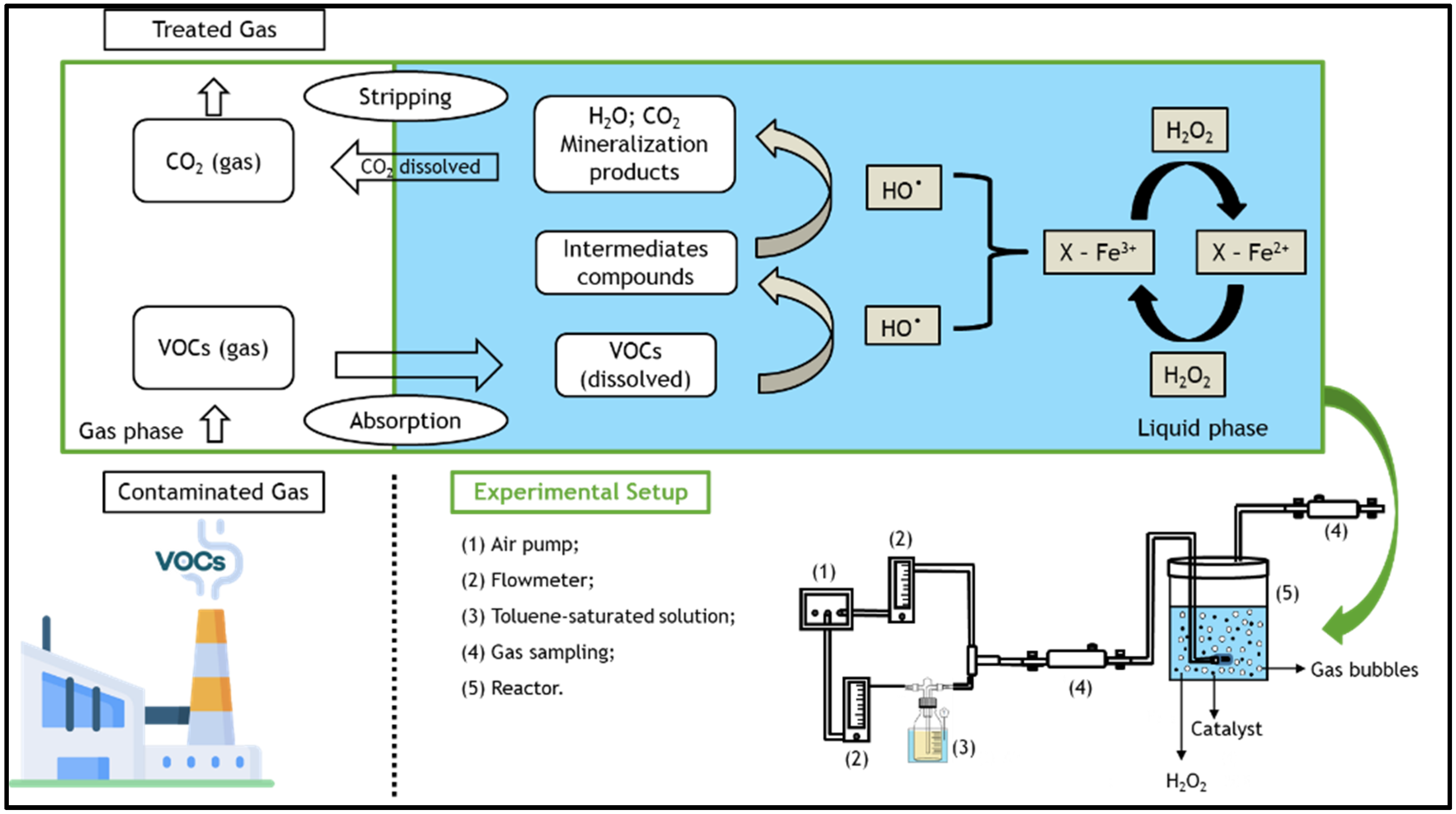
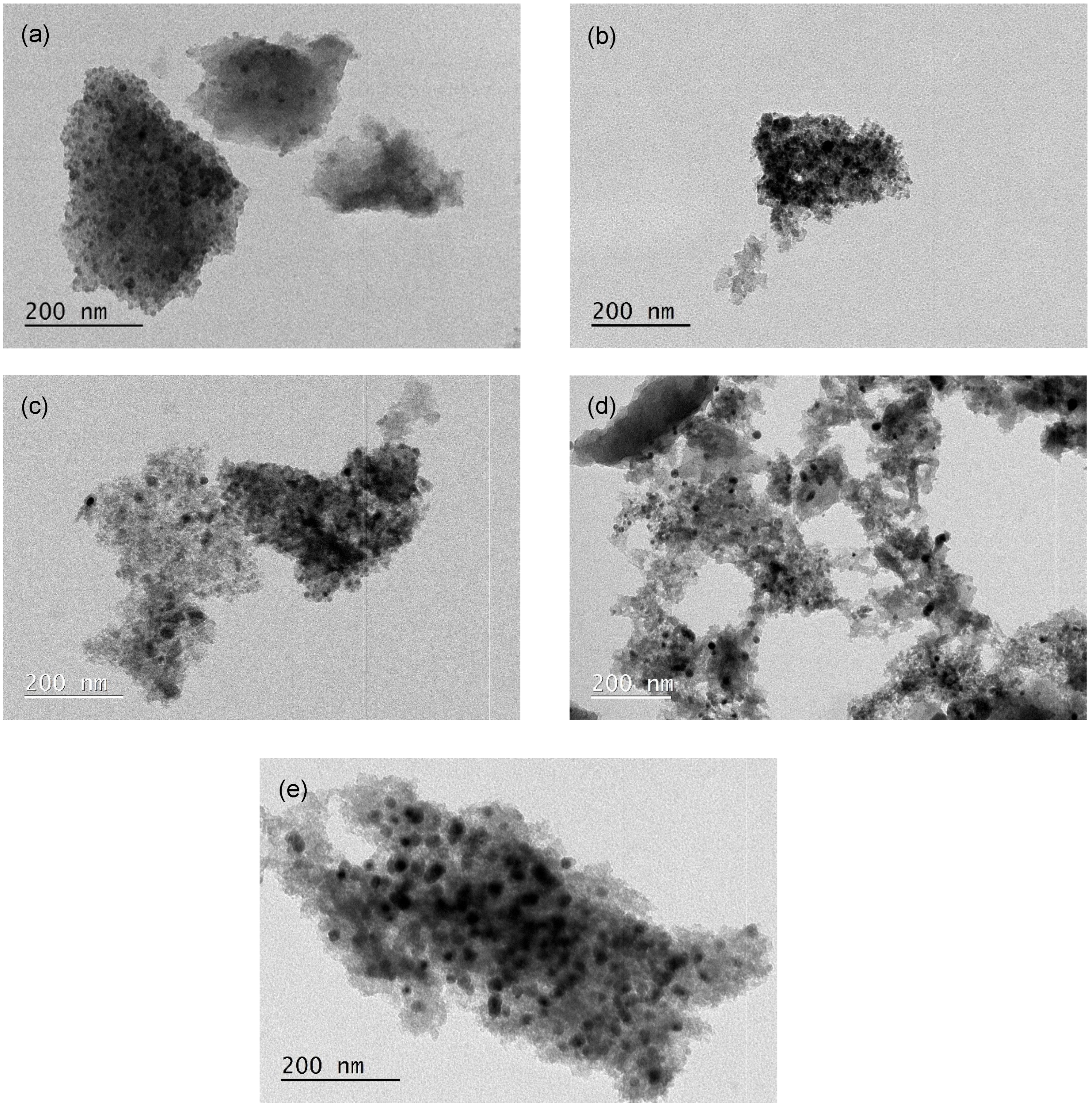

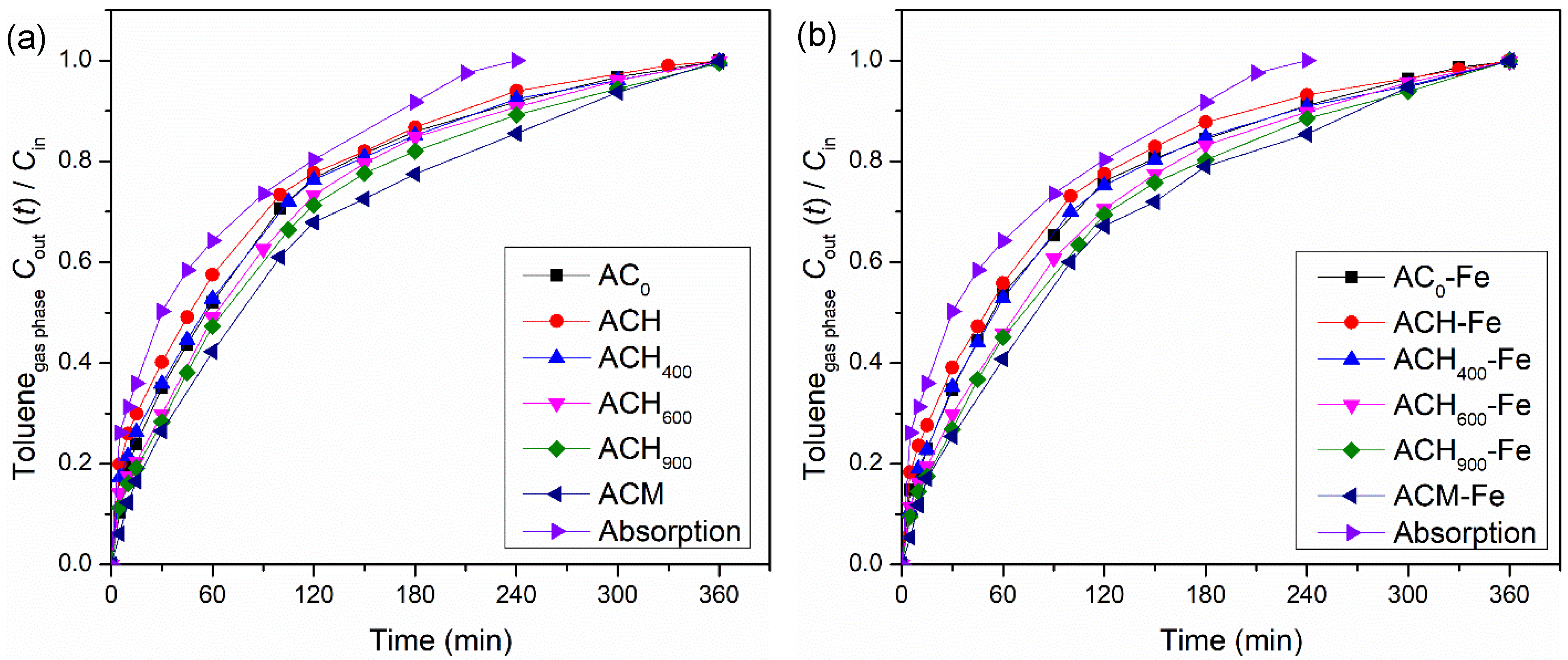
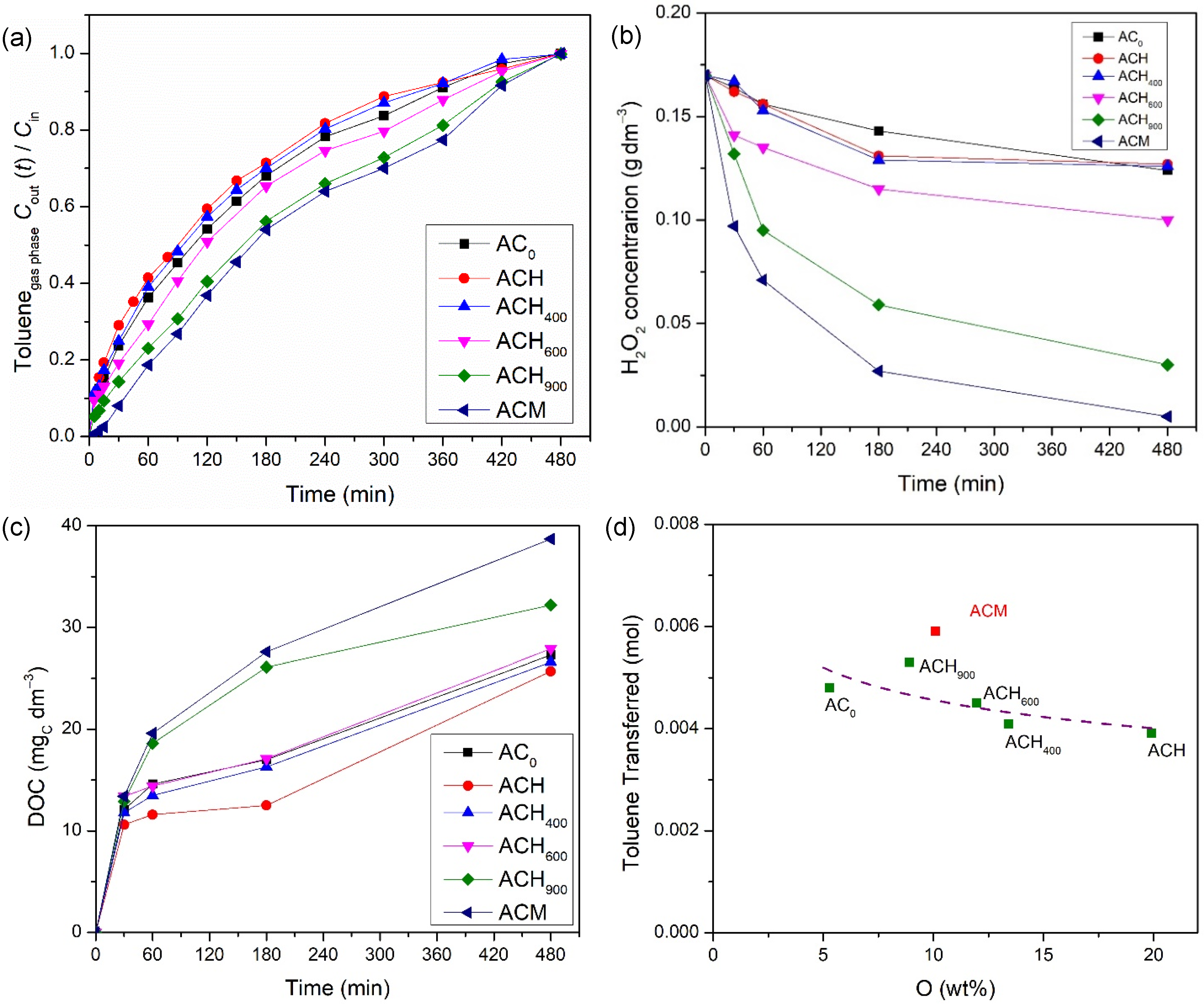



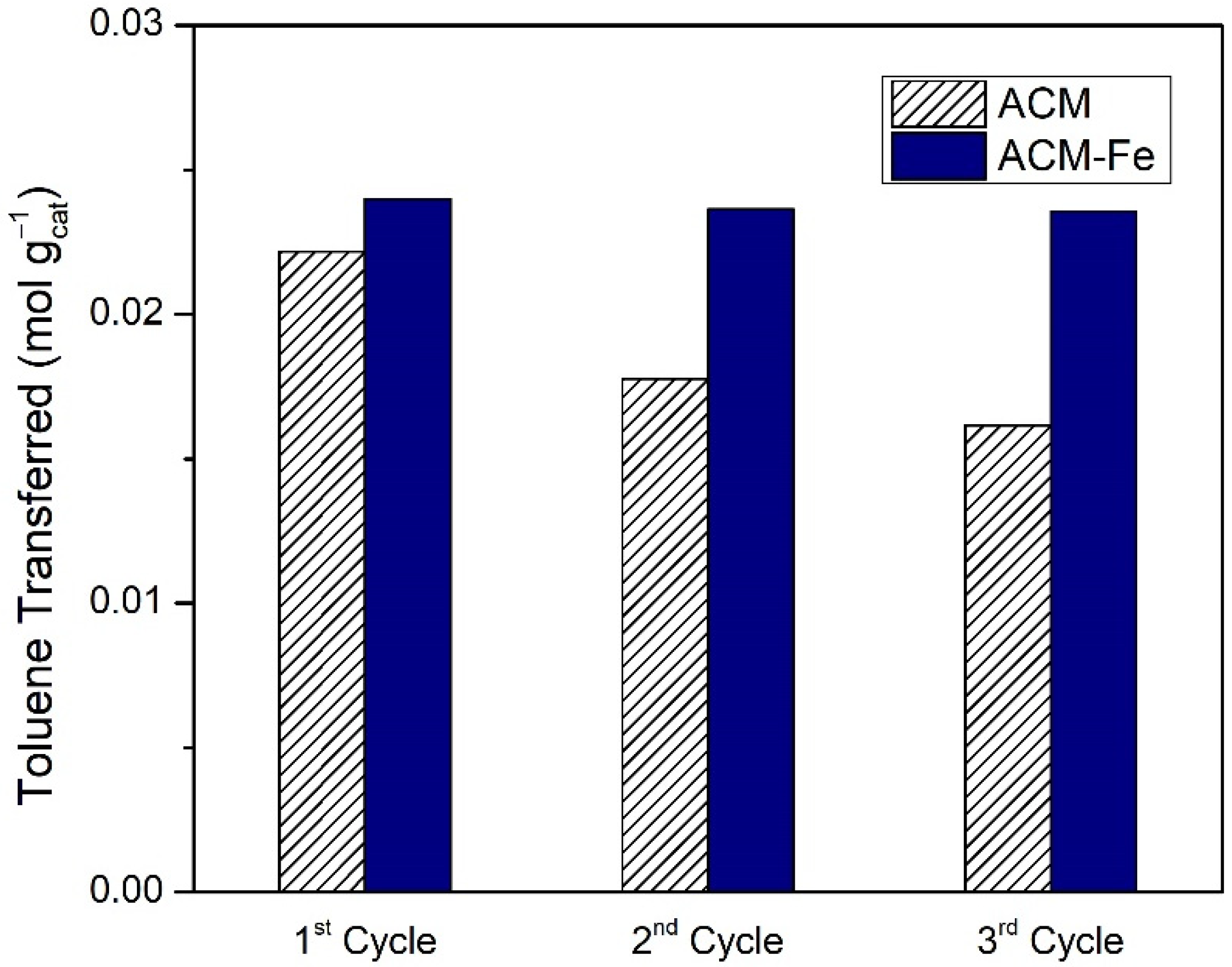
| Acronym | Initial Material | Description of Treatment |
|---|---|---|
| AC0 | Original | None |
| ACH | AC0 | Oxidation in liquid phase with 6 M of HNO3 |
| ACH400 | ACH | Thermal treatment under N2 flow at 400 °C |
| ACH600 | ACH | Thermal treatment under N2 flow at 600 °C |
| ACH900 | ACH | Thermal treatment under N2 flow at 900 °C |
| ACM | AC0 | N-doping using melamine as nitrogen source |
| ACXY-Fe | Altered activated carbons | Incipient wetness impregnation method |
| Material | SBET (±20 m2g−1) | Smeso (±20 m2g−1) | Vmicro (±0.01 cm3g−1) | Vp (±0.01 cm3g−1) |
|---|---|---|---|---|
| AC0 | 1047 | 170 | 0.36 | 0.54 |
| ACH | 968 | 151 | 0.35 | 0.52 |
| ACH400 | 1011 | 159 | 0.32 | 0.49 |
| ACH600 | 1072 | 182 | 0.38 | 0.58 |
| ACH900 | 1059 | 160 | 0.39 | 0.56 |
| ACM | 807 | 125 | 0.28 | 0.42 |
| AC0-Fe | 983 | 162 | 0.34 | 0.53 |
| ACH-Fe | 1010 | 173 | 0.35 | 0.55 |
| ACH400-Fe | 941 | 165 | 0.33 | 0.50 |
| ACH600-Fe | 1043 | 181 | 0.36 | 0.58 |
| ACH900-Fe | 1015 | 171 | 0.35 | 0.53 |
| ACM-Fe | 823 | 84 | 0.32 | 0.44 |
| Sample | C (wt.%) | H (wt.%) | N (wt.%) | S (wt.%) | O (wt.%) | pHPZC |
|---|---|---|---|---|---|---|
| AC0 | 78.60 | 1.94 | 0.00 | 0.08 | 5.28 | 7.6 |
| ACH | 71.50 | 2.84 | 0.63 | 0.03 | 19.91 | 2.6 |
| ACH400 | 72.80 | 2.48 | 0.01 | 0.02 | 13.42 | 6.0 |
| ACH600 | 76.80 | 2.64 | 0.02 | 0.04 | 11.97 | 7.3 |
| ACH900 | 81.10 | 1.99 | 0.00 | 0.14 | 8.92 | 7.5 |
| ACM | 76.30 | 2.64 | 7.01 | 0.06 | 10.08 | 7.5 |
| Material | Weight (%) | ||
|---|---|---|---|
| Volatile Content | Fixed Carbon | Ash | |
| AC0 | 8 | 75 | 17 |
| ACH | 35 | 57 | 8 |
| ACH400 | 16 | 69 | 15 |
| ACH600 | 13 | 68 | 19 |
| ACH900 | 8 | 80 | 12 |
| ACM | 30 | 47 | 23 |
| Material | Iron Content (%) | Leached Iron (mgFe dm−3) | Leached Iron (%) |
|---|---|---|---|
| AC0-Fe | 2.2 | 0.046 | 0.31 |
| ACH-Fe | 2.1 | 0.054 | 0.36 |
| ACH400-Fe | 2.0 | 0.080 | 0.53 |
| ACH600-Fe | 1.8 | 0.070 | 0.47 |
| ACH900-Fe | 1.7 | 0.040 | 0.27 |
| ACM-Fe (1st cycle) | 1.8 | 0.037 | 0.25 |
| ACM-Fe (2nd cycle) | - | 0.005 | 0.41 |
| ACM-Fe (3rd cycle) | - | 0.022 | 0.21 |
Publisher’s Note: MDPI stays neutral with regard to jurisdictional claims in published maps and institutional affiliations. |
© 2022 by the authors. Licensee MDPI, Basel, Switzerland. This article is an open access article distributed under the terms and conditions of the Creative Commons Attribution (CC BY) license (https://creativecommons.org/licenses/by/4.0/).
Share and Cite
Sampaio, E.F.S.; Guimarães, V.; Soares, O.S.G.P.; Pereira, M.F.R.; Rodrigues, C.S.D.; Madeira, L.M. Degradation of Toluene from Gas Streams by Heterogeneous Fenton Oxidation in a Slurry Bubble Reactor with Activated Carbon-Based Catalysts. Nanomaterials 2022, 12, 3274. https://doi.org/10.3390/nano12193274
Sampaio EFS, Guimarães V, Soares OSGP, Pereira MFR, Rodrigues CSD, Madeira LM. Degradation of Toluene from Gas Streams by Heterogeneous Fenton Oxidation in a Slurry Bubble Reactor with Activated Carbon-Based Catalysts. Nanomaterials. 2022; 12(19):3274. https://doi.org/10.3390/nano12193274
Chicago/Turabian StyleSampaio, Emanuel F. S., V. Guimarães, O. S. G. P. Soares, M. Fernando R. Pereira, Carmen S. D. Rodrigues, and Luis M. Madeira. 2022. "Degradation of Toluene from Gas Streams by Heterogeneous Fenton Oxidation in a Slurry Bubble Reactor with Activated Carbon-Based Catalysts" Nanomaterials 12, no. 19: 3274. https://doi.org/10.3390/nano12193274
APA StyleSampaio, E. F. S., Guimarães, V., Soares, O. S. G. P., Pereira, M. F. R., Rodrigues, C. S. D., & Madeira, L. M. (2022). Degradation of Toluene from Gas Streams by Heterogeneous Fenton Oxidation in a Slurry Bubble Reactor with Activated Carbon-Based Catalysts. Nanomaterials, 12(19), 3274. https://doi.org/10.3390/nano12193274











